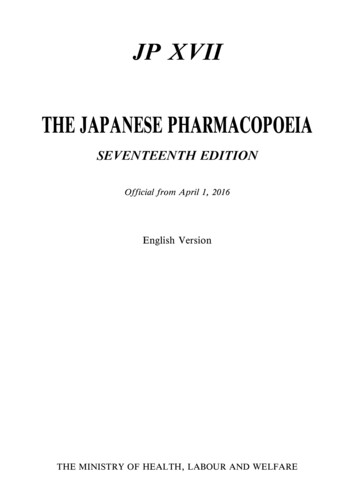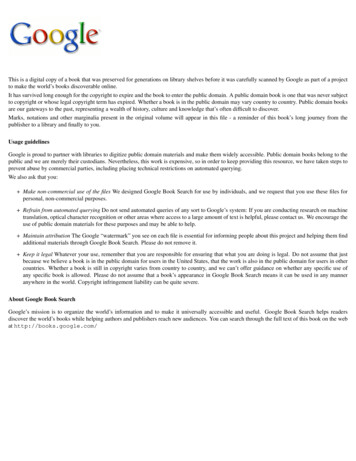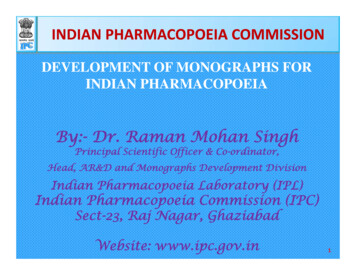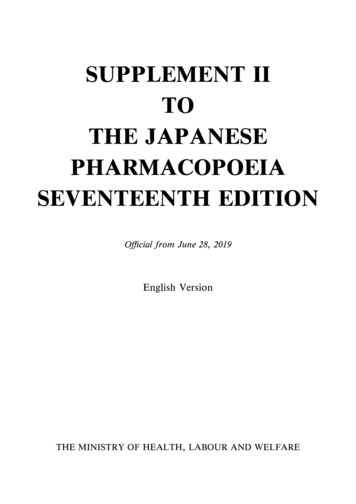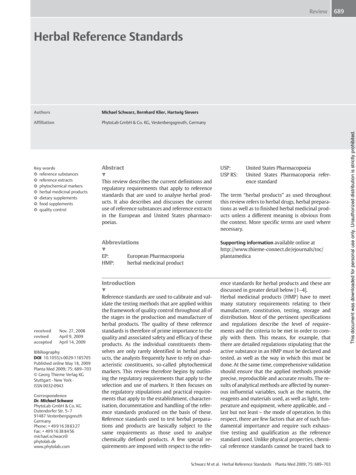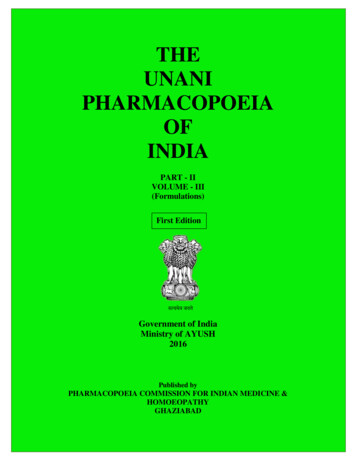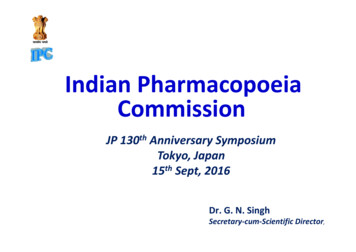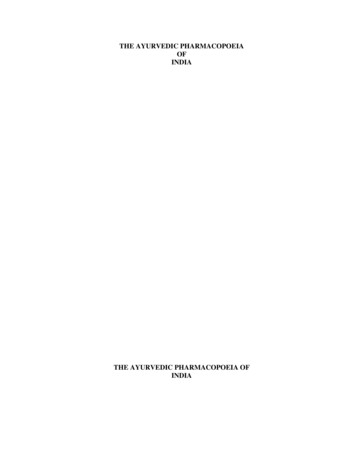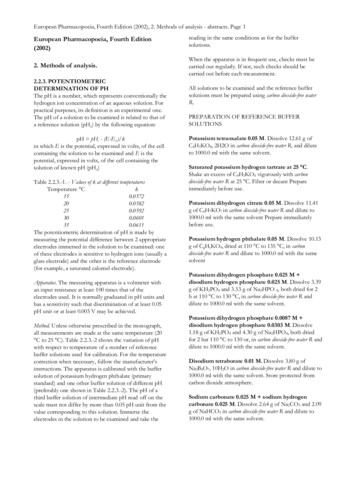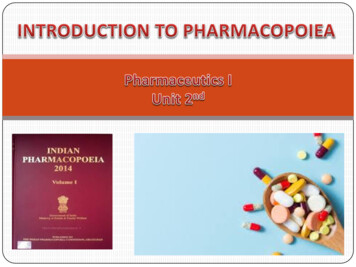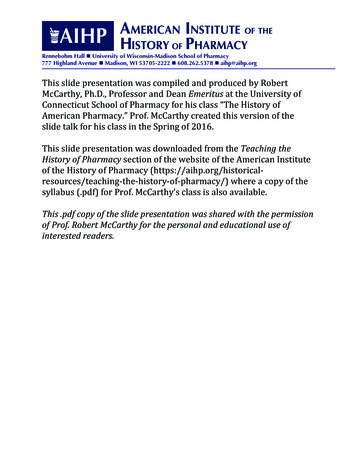
Transcription
Rennebohm Hall n University of Wisconsin-Madison School of Pharmacy777 Highland Avenue n Madison, WI 53705-2222 n 608.262.5378 n aihp@aihp.orgThis slide presentation was compiled and produced by RobertMcCarthy, Ph.D., Professor and Dean Emeritus at the University ofConnecticut School of Pharmacy for his class “The History ofAmerican Pharmacy.” Prof. McCarthy created this version of theslide talk for his class in the Spring of 2016.This slide presentation was downloaded from the Teaching theHistory of Pharmacy section of the website of the American Instituteof the History of Pharmacy -history-of-pharmacy/) where a copy of thesyllabus (.pdf) for Prof. McCarthy’s class is also available.This .pdf copy of the slide presentation was shared with the permissionof Prof. Robert McCarthy for the personal and educational use ofinterested readers.
EVOLUTION OF THEPHARMACOPOEIAPHRX 4001W-002The History of AmericanPharmacySpring 2016
An American Pharmacopeia 1808: The Massachusetts Pharmacopoeia is published providing astate guide to drug standards. The Massachusetts Pharmacopoeia was used by apothecaries to properlyfill prescriptions from physicians since it defined the identity of drugs andpreparations. 1820: The U.S. Pharmacopeial Convention founded in Washington,DC; although all state medical societies were invited to senddelegates, only 11 states attended; only about 200 drugs wereincluded in the first USP since they were the only ones deemed“most fully established and best understood.”
United States Pharmacopoeia (USP) 1830: The first revision of the USP published; revisions continue atan interval of every 10 years. 1848: Congress passes legislation making the USP an officialcompendium. 1888: First National Formulary (NF) published by the AmericanPharmaceutical (now Pharmacists) Association. 1900: USP Convention and Board of Trustees created. 1906: USP and NF standards for strength, quality, and purityrecognized as official.
United States Pharmacopoeia (USP) 1938: USP and NF standards for strength, quality, purity, packaging, andlabeling recognized as official and enforced by FDA; "New Drug" conceptestablished; FDA approves drugs for safety before marketing. 1942: USP revision cycle changed to every 5 years. 1971: USP moves headquarters to Rockville, MD. 1975: USP acquires NF from APhA. 1977: USP and NF scope redefined: USP specifies standards for drugsubstances and dosage forms; NF specifies standards for excipients. 1980: USP and NF published under same cover; USP DispensingInformation (USP DI) published. 1993: Federal Omnibus Budget Reconciliation Acts (OBRA '90 and '93)name USP DI as source of information that state Medicaid agencies canuse for drug utilization review, patient counseling, and medically acceptedoff-label uses of medicines.
United States Pharmacopoeia (USP) 1994: USP signs an agreement with the American MedicalAssociation to combine the information in AMA's Drug Evaluationsdatabase with the USP DI database to develop a single product thatcontains drug and therapeutic information. 2002: USP-NF published annually. 2000s: USP develops offices/laboratories around the world andcollaborates with the pharmacopoeias of other nations indeveloping drug standards.
Source: USP Web Site
National Formulary 1883: NY Pharmacist Samuel Bendiner and NY hospital pharmacistCharles Rice led an effort to modernize the US Pharmacopoeia;Bendiner inspired the creation of the New York and BrooklynFormulary (NYBF); Rice negotiated an agreement to share theinformation in the NYBF to develop a national formulary, which itwas hoped would be used by physicians in prescribing rather thanrecommending the use of proprietary medicines. 1886: APhA published a preliminary draft of the National Formularyof Unofficinal Preparations, asking for feedback from the pharmacyprofession. 1888: The National Formulary (NF) is published for the first time byAPhA. 1906: The second revision of the NF coincides with the passage ofthe Food & Drug Act, which named the NF as one of the officialstandards for pharmaceuticals, much to the surprise of APhA.
National Formulary (NF) The first three editions of the NF provided practicing pharmacists withformulas for small scale compounding, allowing for competition withready-made preparations. 1916: National Formulary IV set “definite standards.” 1935: The NF established a drug standards lab at the University of IllinoisCollege of Pharmacy. 1938: APhA established the Drug Standards Laboratory in Washington,DC.; during the 1960s, this lab was revitalized through financial supportfrom USP (which was using this lab’s services) and the AMA. In 1960, there were discussion of merging the NF and USP; by 1966, formaldiscussion of a merger was underway. 1975: USP purchased both the NF and Drug Standards Laboratory fromAPhA. 1998: USP licensed USP DI to The Thomson Company; USP DI is publishedby their Micromedex subsidiary.
USP Today “USP is a unique organization whose activities are directed by three governingbodies composed of more than 900 volunteers and whose day-to-day operationsare managed by an executive team and staff of more than 800 employees.” “Governance: USP is governed by the Convention membership, the Board ofTrustees, and the Council of Experts and its Expert Committees. These decisionmaking bodies guide USP’s activities in the best interest of quality public health.” “Executive Team: USP’s executive team helps manage all USP operations at itsfive international locations in support of the governing bodies’ standards-settingactivities. USP staff provide support for volunteer and member activities, scientifictesting, quality assurance, standards acquisition, verification services, training indeveloping regions, education programs, customer service, harmonization, andoutreach and communications efforts.”Source: USP Web Site.
USP TodayUSP’s Compendial ActivitiesThe United States Pharmacopeia andthe National Formulary (USP–NF)Food Chemicals CodexUSP Dietary SupplementsCompendiumUSP Medicines Compendium (MC)Reference StandardsOther Resources– Pharmacopeial Forum– FCC Forum– USP Dictionary– Chromatographic Columns
USP Today United States Pharmacopeia 38 - National Formulary 33 Published November 1, 2014; official May 1, 2015 Supplement 1 to the United States Pharmacopeia 38 - National Formulary 33 Published February 1, 2015; official August 1, 2015 Supplement 2 to the United States Pharmacopeia 38 - National Formulary 33 Published June 1, 2015; official December 1, 2015
United States Pharmacopoeia (USP) 1938: USP and NF standards for strength, quality, purity, packaging, and labeling recognized as official and enforced by FDA; "New Drug" concept established; FDA approves drugs for safety before marketing. 1942: USP revision cycle changed to every 5 years. 1971: USP moves headquarters to Rockville, MD.
